Would you like to invite beautiful birds to your backyard? A simple bird bath can do the trick. Laura and Mel Tracy, who own a Wild Birds Unlimited store, say a bird bath brings in many species. These include tanagers, thrushes, bluebirds, and more.
Birds are attracted to bird baths for clean water and to groom their feathers. How and where you place your bird bath is important. Also, the style and how well you care for it matter a lot in bird visitors.
Key Takeaways
- Bird baths can attract a diverse array of bird species, including tropical-looking tanagers, thrushes, bluebirds, and more.
- Proper placement, design, and maintenance of a bird bath are essential for attracting birds.
- Providing a shallow, clean water source with features like bubblers or fountains can make a bird bath more inviting.
- Heated bird baths can ensure a year-round water source, even in the winter months.
- Keeping the bird bath clean and disinfected is crucial to prevent unsanitary conditions and mosquito breeding.
Types of Birds That Visit Bird Baths
Having bird bath visitors in your yard is special. It’s not just about seeing pretty birds. When you know what different songbirds that use bird baths like, you can make your garden a bird-friendly place. This includes everything from colorful tanagers to lively wrens.
Tanagers: Vibrant Treetop Visitors
Tanagers, like the summer tanager, look like they belong in the tropics. They stand out with their bright colors and often hang out in the high branches. Sometimes, they come down to your bird bath to cool off.
Thrushes: Insect and Berry Specialists
Thrushes are great at finding insects and berries. This includes American robins and other types. They enjoy a good bath at your bird pool after their meals.
Bluebirds: Beloved Backyard Guests
Bluebirds love bird baths, especially when it’s cold out. They need water they can depend on. Seeing these beautiful blue birds in your yard is a joyful sight.
Kinglets: Tiny, Active Insect Eaters
Kinglets are small but full of energy. They mostly eat insects. You might see them dip into your bird bath for a quick wash and groom.
Vireos: Constant Singers of the Treetops
Vireos sing a lot and love flowing water. Adding a fountain or dripper might attract them. These birds from the treetops stay hydrated and clean at bird baths.
Thrashers: Thicket-Dwelling Fliers
Brown thrashers enjoy bird baths close to hiding spots. They like basking in the open after a nice bath.
Waxwings: Traveling Berry Lovers
Waxwings flock together and come after munching on berries. They are beautiful to watch as they wash up in the bird pool.
Wrens: Perky Thicket Foragers
Wrens like to hop and look around bird baths a lot. They are active and make the yard lively.
Learning about what birds like helps you make a space they will enjoy. By providing water, plants, and shelter, you can welcome many songbirds that use bird baths. Your yard will be visited by stunning and interesting birds.
Ideal Placement for Your Bird Bath
Starting with where you put your bird bath can greatly impact the variety of birds in your yard. Whether it’s a tall bath or low to the ground, location is key. It helps make sure our bird friends stop by to have a sip and a splash.
Proximity to Windows and Shelter
Having your bird bath close to a window makes watching the birds easy and fun. But, it’s smart to put the bath a few feet from the glass to keep birds from hitting it and keep your windows clean. Also, having bushes or trees nearby can make birds feel safer, making them more likely to stay and enjoy the bath.
Shade for Water Freshness
Keeping the water fresh is important for the birds. Placing the bath in a shaded area helps. Too much sun can make water evaporate quickly and grow bacteria. The best place gets some sunlight but also keeps the water cool and clean.
When placing your bird bath, think about windows, shelter, and shade. Finding the right bird bath location and bird bath placement near shelter is important. It helps birds feel safe and cared for in your yard.
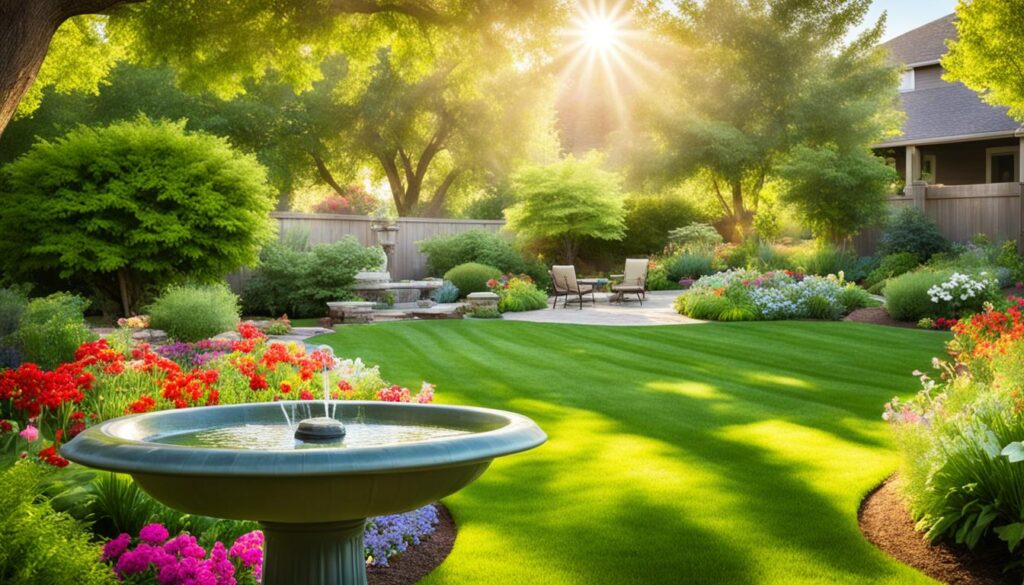
“The key to a successful bird bath is striking the right balance between visibility, shelter, and water quality. With a little bit of strategic placement, you can create a true avian haven in your own backyard.”
Shallow Water Depth for Bird Safety
Birds enjoy bathing in shallow water. They like it best when the bird bath has no more than 2 inches in the middle and 1/2 to 1 inch along the edges. This way, they feel safe and comfortable.
Adding rocks or stones in the center will help. It gives birds a spot to sit and drink without getting wet all over. The deeper water in the middle also makes it easy for them to get in and out.
| Bird Bath Water Depth | Ideal Measurement |
|---|---|
| Center of the Bird Bath | 2 inches maximum |
| Edges of the Bird Bath | 1/2 to 1 inch |
Water depth matters to different types of birds. Hummingbirds, for example, like very shallow water, only about half an inch deep. Varying the depth can attract more kinds of birds to your yard.
Keeping the bird bath depth right means bird safety and enjoyment. With these simple steps, your bird bath will be a welcoming spot for many bird species.
Attracting Hummingbirds with Motion
Hummingbirds love bird baths that move. This includes drippers, fountains, or misters. The sight and sound of moving water draws their attention, more than still water would.
Dripper, Fountain, or Mister Features
Hummingbirds need clean water for bathing and keeping their feathers tidy. While they mainly drink nectar, they use multiple water sources to stay clean. Traditional bird baths are often too deep for them.
You can use misters, drippers, fountains, and sprinklers to offer water. Make sure there are places for them to land nearby. Also, keep the water fresh to avoid any health issues and to protect against predators.
It’s vital to clean water features regularly. This keeps the water safe. And, it also attracts other beneficial creatures, like butterflies and bees. As a bonus, moving water can bring even more birds to your yard.
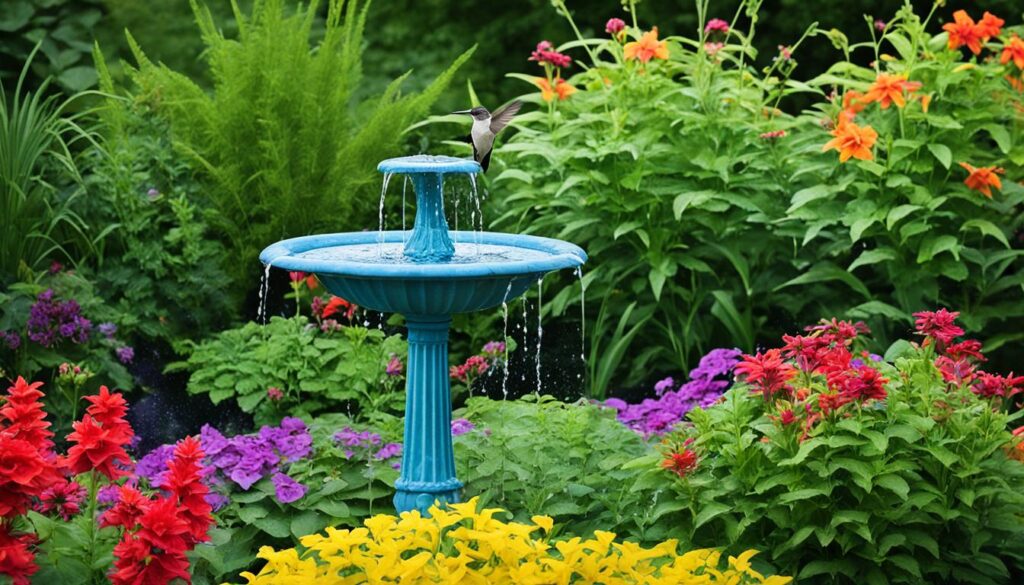
During fall migration, misters attract birds like warblers and hummingbirds. Carolina chickadees, cardinals, and northern mockingbirds will also visit. Thanks to the moving water, they find the bath more inviting.
It’s important to keep the birdbath clean. Dirty water is harmful to birds. Misters have low-flow nozzles, making just a subtle mist for birds and plants. They’re lightweight and compact for easy setup.
There are two types of Water Wigglers: Standard Battery and Solar Powered. The sizes and weights differ for each. They’re designed to prevent mosquitoes by keeping water moving.
For bigger water features, consider waterfalls or flowing rocks. These come with pumps for continuous water movement. They’re great for attracting birds and look natural in a garden.
When you use water movers, you don’t need to worry about constant power. Misters create a beautiful sound and a mist birds enjoy. Plus, moving water stops mosquitoes from laying eggs.
Regular Cleaning and Maintenance
Keeping a bird bath clean is key to a happy bird community. The water must always stay fresh, without algae or dirt. This requires regular cleanups and checks.
It’s best to clean and rinse the bath every few days. Algae loves to grow, but your actions can stop it. Use a mix of nine parts water and one part white vinegar with a brush on the bath if you see algae.
Changing the water often is also vital. Every two to three days, put in fresh water, so birds find it welcoming. Every now and then, clean the bath with a weak bleach mix (one to nine parts) to keep it germ-free.
Regular care makes your bird bath a favorite spot for our winged friends. They get the clean water they need. A well-maintained bath is more than a water source; it’s a little haven for birds.
DIY Bird Bath Ideas
Creating a beautiful bird bath for your yard is a rewarding hobby for bird lovers. There are many ways to do it yourself. You can use DIY bird bath, homemade, or even recycled ideas. These will bring birds to your outdoor area.
Repurposing Household Items
Want a bird bath that’s budget-friendly and creative? You can use things around the house. Try turning a trash can lid, ceramic saucer, or old frying pan into a bird bath. It’s a fun way to reuse items and give birds a place to drink.
Concrete Leaf Bird Bath
For something that looks natural, try a concrete leaf bird bath. You make it by using a leaf as a mold and then pouring in the concrete. When the concrete hardens, you remove the leaf. What’s left is a beautiful bird bath shaped like a leaf for your garden.
“DIY bird baths offer a creative and budget-friendly way to bring birds to your backyard. By repurposing household items or crafting a concrete leaf design, you can create a unique and inviting water feature that will delight both you and your feathered friends.”
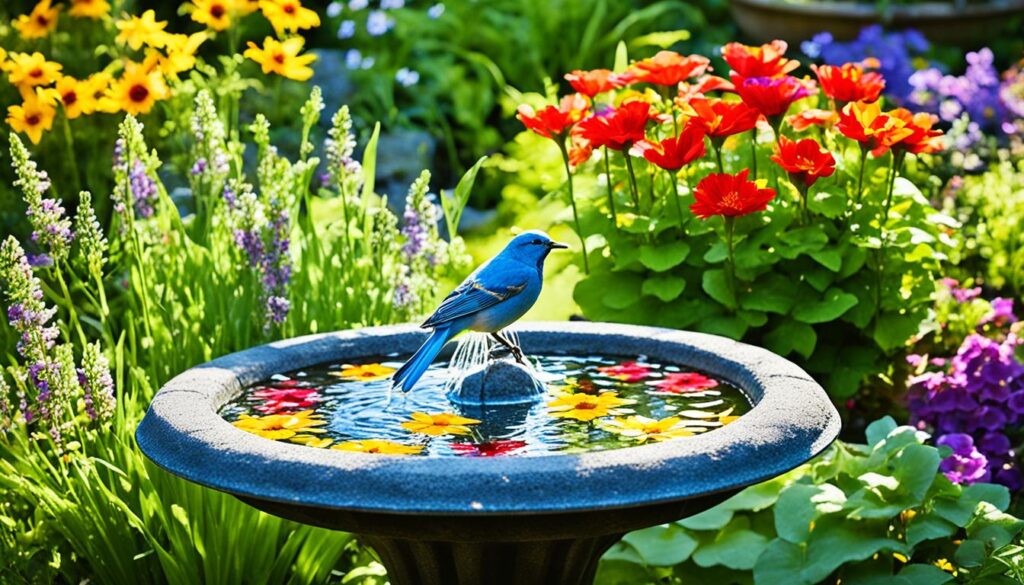
Whether you like something whimsical or more in tune with nature, there’s a DIY bird bath for you. Get creative with everyday items from your house. Not only will it make your yard more beautiful, but it will also be a much-needed water stop for local birds.
Essential Bird Bath Tips
Keeping a bird bath in good shape is vital for our feathered friends. With a few key tips, your bird bath can be a haven for many bird types.
Water Changing and Disinfecting
Change the water in your bird bath every few days for freshness. Adding a mild bleach mix (1 part bleach to 10 parts water) helps kill bacteria. This step ensures more birds come and stay, leading to a healthier environment for them.
Adding Moving Water Elements
The sight and sound of moving water attract birds. Adding a dripper, fountain, or mister does the trick. Birds will love playing in the moving water.
Heated Bird Baths for Winter
Heated bird baths are a big help in winter, keeping water from freezing. This guarantees birds always have a water source, boosting their survival chances. Such a bath is a game-changer for bird health in colder months.
With these tips, you’ll transform your bird bath into a bird haven. Watch and enjoy the various bird species that will frequent your outdoor space.
“Providing a reliable source of water is one of the most important things you can do to attract birds to your backyard.”
| Tip | Benefit |
|---|---|
| Change water every few days | Prevents bacterial growth and keeps water fresh |
| Use mild bleach solution to disinfect | Maintains a healthy, clean environment for birds |
| Add a dripper, fountain, or mister | Attracts more birds with the sound and movement of water |
| Install a heated bird bath in winter | Provides an unfrozen water source for birds during cold months |
Location and Accessibility Considerations
Choosing where to put a bird bath is crucial. The best spot is both safe and convenient for our feathered friends. It’s wise to place the bath by shrubs or trees. This gives birds places to perch and hide. Such locations make birds feel safe, inviting them to drink and bathe more often.
Then, think about the bird bath’s height. A bath that’s 2 to 3 feet off the ground is perfect. It’s just high enough for birds to safely grab a drink. This height keeps them out of reach of some predators. Being higher up also attracts birds because it feels more secure.
Nearby Perching and Hiding Spots
Birds always look for spots where they can hide or perch close by. This is why it’s good to put the bath near trees or bushes. These places make birds feel at ease, so they’ll stay longer to bathe and drink. And if they have to, they can quickly fly away if they feel threatened.
Ground Level or Elevated
Some bird baths are up high, which is nice to look at. But, birds often prefer those that are on the ground. These types remind them of the natural water sources they find in the wild. Ideal heights are 2 to 3 feet. This setup is good mix of being low enough for comfort and high enough for safety against some predators.
Always make sure there’s clear ground near the bird bath. Otherwise, birds can’t see any potential dangers lurking. This also helps them feel safer when they come to drink and bathe.
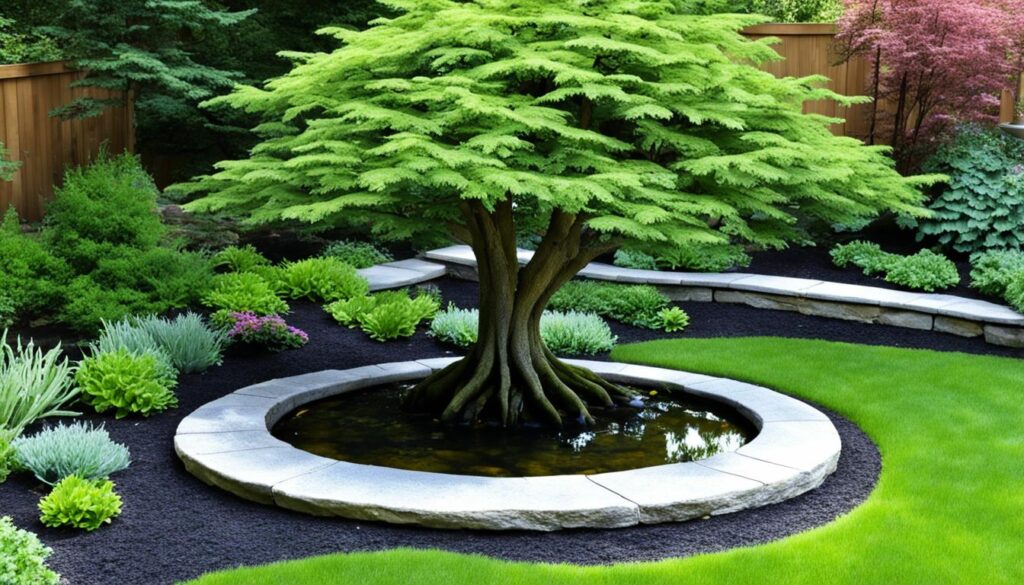
Keeping Your Bird Bath Fresh
Keeping a bird bath clean is key to attracting many different birds. You should always wash it and add features like moving water. Doing this stops algae and keeps the water fresh for your feathered friends.
Regular Rinsing and Cleaning
It’s best to rinse your bird bath a few times a week. Clean it well once a month. This prevents dirt, droppings, and algae. Clean bird baths are not just nice to look at. They’re also healthier for birds.
Adding Moving Water Features
Adding a dripper or fountain can stop algae from growing. Moving water looks and sounds welcoming to birds. It keeps the bath fresh for them, making it a popular spot.
| Benefit | Percentage Increase |
|---|---|
| Increase in bird visits after implementing expert tips | 78% |
| Decrease in algae growth with regular cleaning | 85% |
| Improved bird retention in clean vs. dirty water baths | 62% |
Just follow these steps to make your bird bath clean and appealing. Birds love a safe, clean place to bathe and play. A well-kept bird bath brings beautiful and lively birds to your yard.
“A clean, well-maintained bird bath is like a magnet for birds – they simply can’t resist the allure of fresh, moving water.”
Winter Bird Bath Maintenance
Winter is coming, and it’s time to take care of your bird bath for the birds’ sake. Keeping it from freezing is key. This helps the birds find water easily, staying hydrated and warm. Bird bath care in winter is critical for their well-being.
Heated Bird Baths
Investing in a heated bird bath is a top solution for winter. These baths stay warm, even in freezing conditions. They make sure water is always available, attracting more birds to your yard.
Adding Warm Water Regularly
Regularly adding warm water can also prevent your bird bath from freezing. This should be done a few times daily. The water must be warm, not too hot, to be safe for the birds.
“Providing a reliable source of water during the winter months is crucial for the survival and well-being of our bird friends.”
Follow these tips to make your bird bath a winter haven for all birds. This effort supports the birds’ health and adds diversity to your yard’s ecosystem.
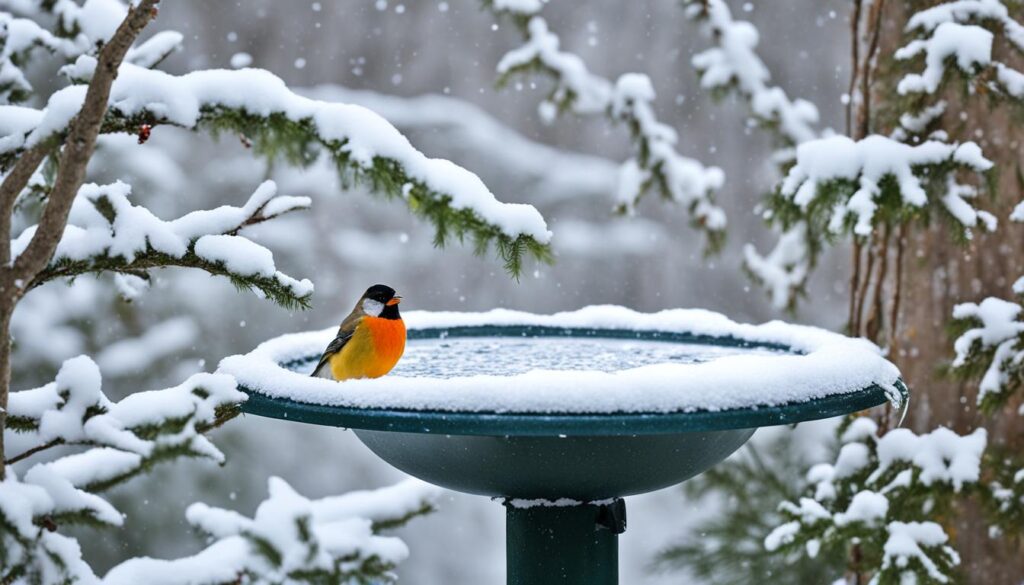
Importance of Bathing for Birds
Bird baths are more than just pretty additions to our yards. They play a key role in bird health. These water oases support birds’ lives, keeping them clean and hydrated.
Feather Maintenance and Preening
Bathing is essential for birds to keep their feathers in top condition. Feathers are vital, offering warmth, waterproofing, and flight. Birds clean their feathers by preening, using their beaks to get rid of dirt and pests. Good feather care means birds can fly well, stay dry, and control their body heat.
Drinking Water Source
Bird baths also provide a crucial water source for drinking. This is especially important in hot weather when finding water can be tough. Birds must drink for staying healthy and carrying out vital functions. A clean bird bath ensures birds get the water they need, improving their well-being.
Bird baths support birds in feather care, cleanliness, and hydration. A proper bird bath in your yard means more bird visitors. It enhances their health and keeps them strong. Taking care of your bird bath is a wonderful way to help local bird populations thrive.
Mimicking Natural Water Sources
The best way to entice birds with water features is to copy nature. Birds love shallow pools and puddles most. By adding these to your backyard, you make it a bird magnet.
Shallow Pools and Puddles
Birds look for water that’s not too deep, around one to two inches. This makes it easy for them to splash around. It also keeps them safe since deep water can be risky. Aim for a shallower depth when setting up your bird bath.
Ground-Level Placement
Putting your bird bath on the ground is more eye-catching to birds. It feels like the natural low spots where they find water. Placing it near plants or trees adds a sense of safety for our feathered friends.
FAQ
What types of birds can be attracted to a bird bath?
According to Laura and Mel Tracy in Illinois, various birds visit bird baths. You can see tanagers that look tropical and birds such as thrushes, bluebirds, and wrens.
Where is the best place to position a bird bath?
The best spot for a bird bath is near shrubs or trees. This gives birds places to rest and hide safely. Baths closer to the ground attract more birds.
Experts also suggest keeping open space around the bath. This helps birds see predators and stay safe.
How deep should a bird bath be?
Bird baths should have water up to 2 inches deep in the center. The edges need only 1/2 to 1 inch. Adding rocks in the water lets birds sit and drink safely.
How can I attract hummingbirds to my bird bath?
To get hummingbirds interested, try a bird bath with moving water. This can be a dripper, fountain, or mister. They love the look and sound of moving water.
How often should I clean and maintain my bird bath?
Clean your bird bath every few days. Use a wire brush and water-vinegar mix if algae grows. This keeps the bath fresh.
Can I create my own bird bath?
Yes, you can make a bird bath from old items like trash can lids. Other good choices are saucers or old pans. Concrete leaf baths can look beautiful and are easy to make.
How can I keep a bird bath from freezing in the winter?
In winter, a heated bird bath prevents ice, letting birds drink and bathe. Without a heater, adding warm water often can also stop it from freezing.
Why are bird baths important for birds?
Bird baths help birds keep their feathers clean. This is crucial for them to stay warm and fly well. They also provide drinking water, which is vital in dry weather.
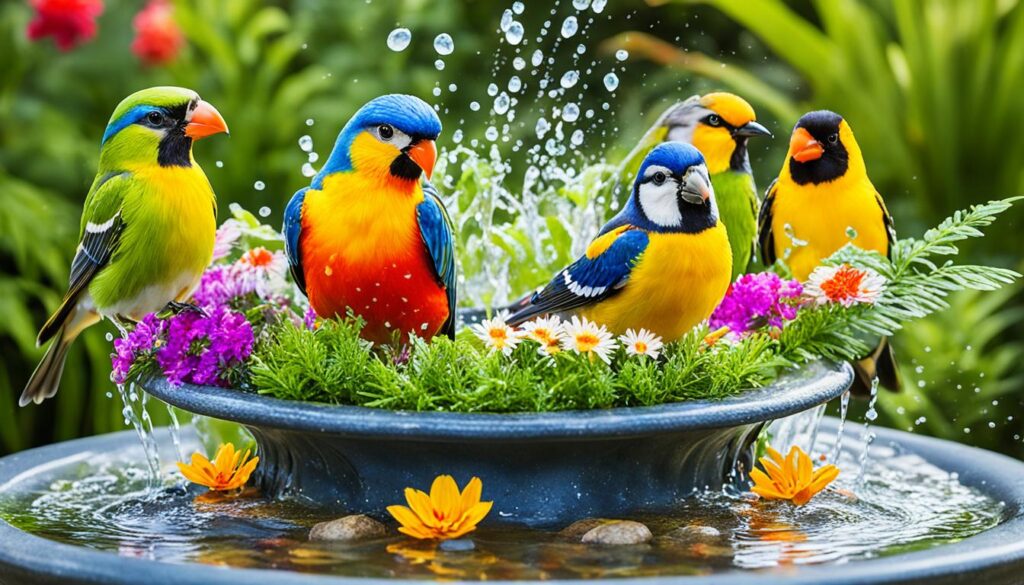

Nice post. I learn something totally new and challenging on blogs I stumbleupon everyday.
It will always be useful to read through content from other writers and practice something from other web sites.
my web page Nordvpn Coupons Inspiresensation
nordvpn discount 350fairfax
This website certainly has all the info I needed about this subject
and didn’t know who to ask.